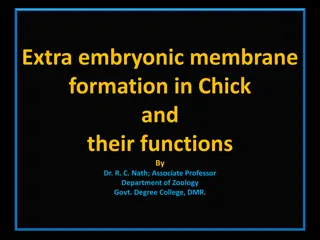Extra Slides
Overexpression of miRNAs in carcinogenesis, Wilms' tumor in children, choristoma, hematogenous spread, radiation effects, genetic factors like Rb gene and TP53, APC mutations, tumor grading, CEA and alpha-fetoprotein tumor markers, cancer cachexia, and pathology fellowships available for medical graduates in various specialties.
Download Presentation

Please find below an Image/Link to download the presentation.
The content on the website is provided AS IS for your information and personal use only. It may not be sold, licensed, or shared on other websites without obtaining consent from the author.If you encounter any issues during the download, it is possible that the publisher has removed the file from their server.
You are allowed to download the files provided on this website for personal or commercial use, subject to the condition that they are used lawfully. All files are the property of their respective owners.
The content on the website is provided AS IS for your information and personal use only. It may not be sold, licensed, or shared on other websites without obtaining consent from the author.
E N D
Presentation Transcript
Extra Slides Extra Slides
Overexpression of miRNAs can contribute to carcinogenesis by reducing the expression of tumor suppressors, while deletion or loss of expression of miRNAs can lead to overexpression of proto-oncogenes. 1. Wilms' tumor: is a cancer of the kidneys that typically occurs in children, rarely in adults. It is named after Dr Max Wilms, the German surgeon. 2. ????: mass consisting of disorganized tissue. 3. Choristoma: 4. 4 exceptions: 5. Hematogenous spread: 6. Radiation & cancer:
7. 8. 9. Microbes & site of tumors: Ph & c-MYC translocations: Vinyl chloride: colorless compound is an important industrial chemical chiefly used, hepatotoxicity leading to angiosarcoma. 10. Naphthylamine: 2 types, aromatic amine what once was used to make azo dyes. It is a known carcinogen and has largely been replaced by less toxic compound. 2-Naphthylamine is found in cigarette smoke and suspected to contribute to the development of bladder cancer. 11. Rb gene on chromosome 13 & TP53 gene ch 17p: 12. Adenomatous polyposis coli (APC): result in familial adenomatous polyposis (FAP) which are three types, here (APC mutation) the dominant type, like NF2, contact inhibitor) & then colorectal cancer, beta-catenin, is controlled by the APC protein (Wnt signaling pathway).
13. Grading and staging: 14. Tumor markers & uses: 15. Carcinoembryonic antigen (CEA): glycosyl phosphatidyl inositol (GPI) cell surface anchored glycoproteins whose specialized sialofucosylated glycoforms serve as functional colon carcinoma L-selectin and E- selectin ligands, which may be critical to the metastatic dissemination of colon carcinoma cells. 16. Alpha-fetoprotein: produced by the yolk sac and the liver during fetal development, elevated in many conditions, like liver cancer and pregnancy. 17. Cancer cachexia.
Pathology Pathology Fellowship of RCPA for Medical Graduates (apart from diplomas): Anatomical Pathology: (SP/HP), (in NA other clinical pathology). Chemical Pathology (BC, MC, ). Clinical Pathology. Forensic Pathology. General Pathology. Genetic Pathology. Haematology. Immunopathology. Microbiology.
Hematology & Immunology Hematology & Immunology Clinical: Medicine or Pediatric. Pathology: NA or UK/AU, Residency, PhD. Research: transitional/basic
KSF Pathology Programs KSF Pathology Programs Hematopathology & Blood Transfusion: Bone Marrow report: Leukemia & some lymphoma and others. Peripheral blood smear and other routine hematology lab (core lab): cytology & HE. Coagulation tests and anti-coagulant clinic: Transfusion Medicine & cellular therapy in future. Laboratory administration and quality management.
If you've followed this so far, lets keep going. Once its invasive, it depends on spread. If its all over the body (mets) then its stage 4. If its just a little invaded (and this differs from cancer to cancer on "how much invasion does it take to upstage"), its stage 2 or 3. Carcinoma in situ by defintion is Stage 1, that is, limited to the tissue without invasion through the basement membrane. How does it get into the rest of the body? Either by local invasion (the picture i showed) or by lymph or blood spread. What is right on the other side of that basement membrane? Yep. Blood vessels and lymph. Also neural tissue, which is why reports will usually see no vascular or perineural involvement. Think of the basement membrane as the flood gate. You've got the mighty mississippi on one side (the cancer), and the entirety of southwest louisiana on the other (the body). If you don't get this reference, you should pay more attention to CNN. As long as the flood gates are closed (basement membrane intact) the river stays in the river. But once you open that gate up (invasion), the mississippi is going to flood everywhere. Neurons, Lymph, Blood, and then its up to you to stage, that is, find how far the cancer has gotten to determine treatment.
To get back to benign vs not, there are tumors that will grow. And they grow alot. But a benign tumor just never invades. That's what makes it benign. Benign = will not invade. It can get huge, steal all the person's blood, destroy organs, literally eat the person from the inside out, but its still "benign" because it wont invade. Malignant tumors invade. Malignant tumors are those that will invade. A carcinoma in situ squamous cell carcinoma of the cervix, for example, is malignant. I suppose, much like a polyp in the colon, it could be considered "pre-malignant" because it "hasn't invaded yet." But "premalignant" and "benign" are not the same thing. Using colon cancer as an example, a tubular pedunculated polyp is benign, as in, not pre-cancer, so you only have to increase the screening a little. A Sessile, villous tumor with active dysplasia is premalignant, and screening is stepped up alot.
So in summary: Benign = tumor will not invade. Malignant = tumor will invade. Premalignant = tumor hasn't invaded yet but it will. Carcinoma in Situ = tumor that hasn't invaded the basement membrane. Carcinoma in Situ = Stage 1 = curable with local resection only. Stage 2 = a little out of the basement membrane (variable per cancer). Stage 3 = a little more out from the basement membrane (variable per cancer). Stage 4 = Metastasis.























